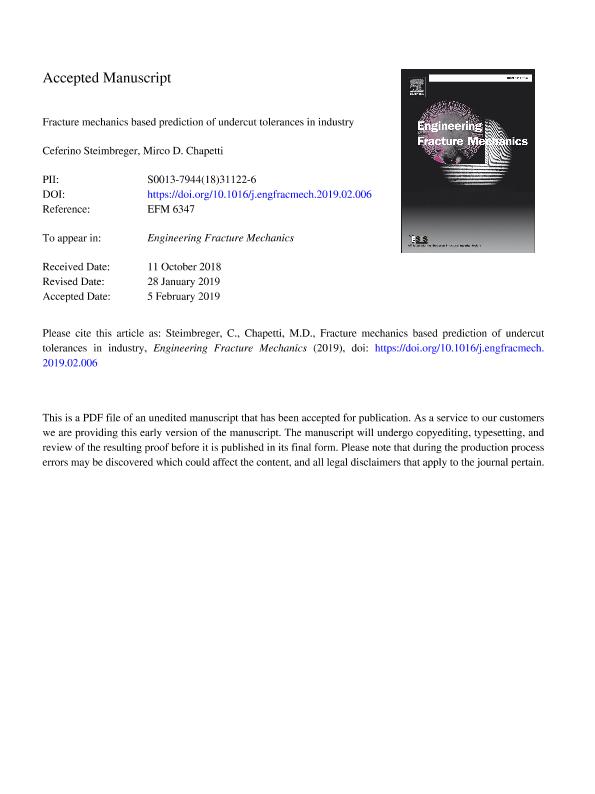Mostrar el registro sencillo del ítem
dc.contributor.author
Steimbreger, Ceferino

dc.contributor.author
Chapetti, Mirco Daniel

dc.date.available
2020-11-27T18:07:07Z
dc.date.issued
2019-04
dc.identifier.citation
Steimbreger, Ceferino; Chapetti, Mirco Daniel; Fracture mechanics based prediction of undercut tolerances in industry; Pergamon-Elsevier Science Ltd; Engineering Fracture Mechanics; 211; 4-2019; 32-46
dc.identifier.issn
0013-7944
dc.identifier.uri
http://hdl.handle.net/11336/119267
dc.description.abstract
Undercuts are geometrical discontinuities or grooves along the toe of a weld caused by loss of the parent material that remain unfilled by weld metal. Regardless of their causes, undercuts can be found in structures and components, in the majority of joints and most of the welding processes. Due to their frequency of appearance in welded structures and their detrimental effects on component life, undercut acceptance criteria had to be regulated by construction codes and standards. Depending on the area where the component is in service, specific tolerances must be satisfied in order to accept or reject the part. In general, undercut depth is considered to be the limiting parameter for this kind of imperfection. However, there is currently in industry no agreement about which value of depth is tolerable for a desired fatigue strength. The purposes of the present paper are twofold. First, to summarise the state of art associated to undercut tolerances in different codes, standards and recommendation documents, for different industries and applications. Secondly, to employ a fracture mechanics based methodology to predict safe undercut dimensions for butt welds subjected to fatigue. Predictions are in good agreement with experimental results from literature, and proposed method proved to be helpful for assessing weld discontinuities.
dc.format
application/pdf
dc.language.iso
eng
dc.publisher
Pergamon-Elsevier Science Ltd

dc.rights
info:eu-repo/semantics/openAccess
dc.rights.uri
https://creativecommons.org/licenses/by-nc-sa/2.5/ar/
dc.subject
FATIGUE STRENGTH
dc.subject
FRACTURE MECHANICS APPROACH
dc.subject
STANDARDS
dc.subject
UNDERCUT
dc.subject
WELDED JOINTS
dc.subject.classification
Ingeniería de los Materiales

dc.subject.classification
Ingeniería de los Materiales

dc.subject.classification
INGENIERÍAS Y TECNOLOGÍAS

dc.title
Fracture mechanics based prediction of undercut tolerances in industry
dc.type
info:eu-repo/semantics/article
dc.type
info:ar-repo/semantics/artículo
dc.type
info:eu-repo/semantics/publishedVersion
dc.date.updated
2020-11-16T20:06:36Z
dc.journal.volume
211
dc.journal.pagination
32-46
dc.journal.pais
Países Bajos

dc.journal.ciudad
Amsterdam
dc.description.fil
Fil: Steimbreger, Ceferino. Consejo Nacional de Investigaciones Científicas y Técnicas. Centro Científico Tecnológico Conicet - Mar del Plata. Instituto de Investigaciones en Ciencia y Tecnología de Materiales. Universidad Nacional de Mar del Plata. Facultad de Ingeniería. Instituto de Investigaciones en Ciencia y Tecnología de Materiales; Argentina
dc.description.fil
Fil: Chapetti, Mirco Daniel. Consejo Nacional de Investigaciones Científicas y Técnicas. Centro Científico Tecnológico Conicet - Mar del Plata. Instituto de Investigaciones en Ciencia y Tecnología de Materiales. Universidad Nacional de Mar del Plata. Facultad de Ingeniería. Instituto de Investigaciones en Ciencia y Tecnología de Materiales; Argentina
dc.journal.title
Engineering Fracture Mechanics

dc.relation.alternativeid
info:eu-repo/semantics/altIdentifier/url/https://www.sciencedirect.com/science/article/pii/S0013794418311226
dc.relation.alternativeid
info:eu-repo/semantics/altIdentifier/doi/http://dx.doi.org/10.1016/j.engfracmech.2019.02.006
Archivos asociados
